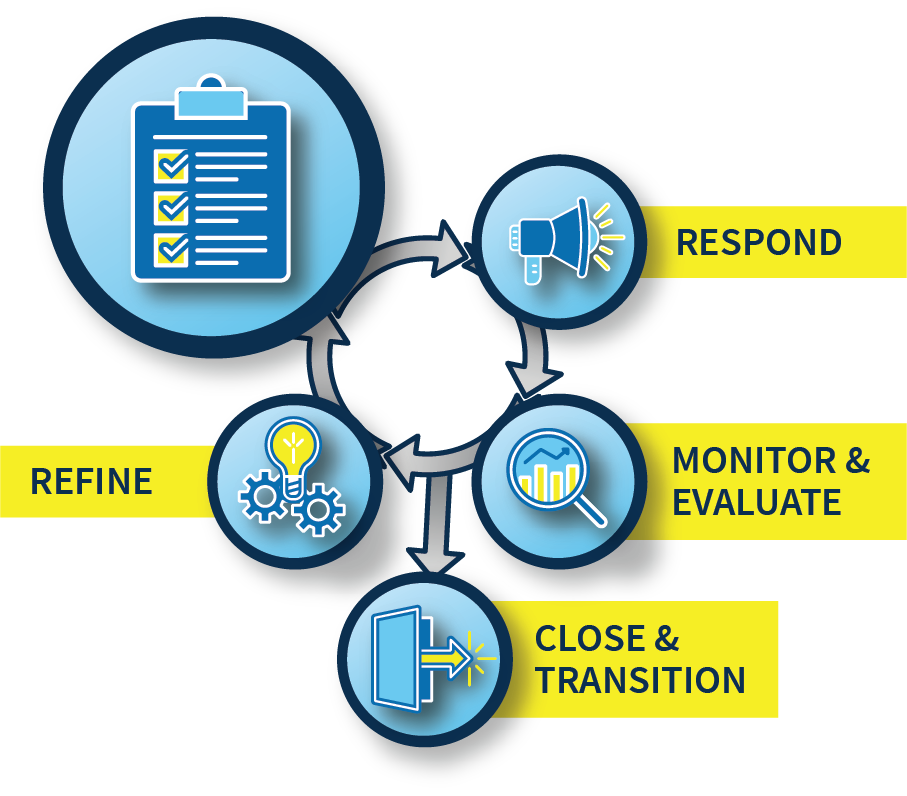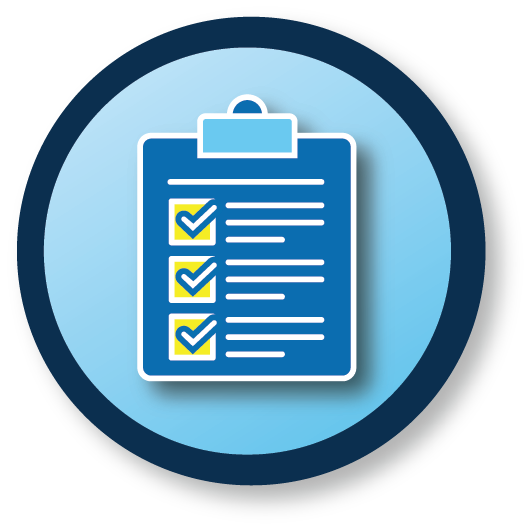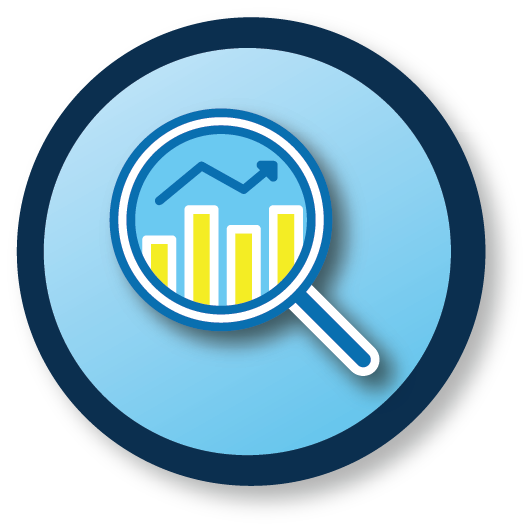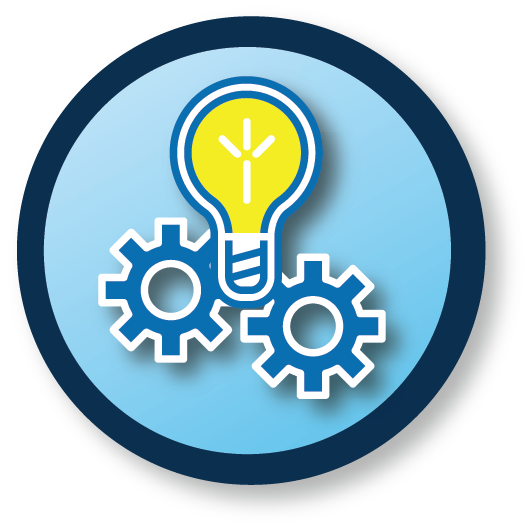
CLARIFY MISSION, DEFINE SCOPE AND APPROACH

ESTABLISH AN OVERSIGHT TEAM

ESTABLISH A CAMPAIGN MANAGEMENT TEAM

DEFINE DESIRED OUTCOME

IDENTIFY FACTORS THAT MAY IMPACT CAMPAIGN SUCCESS

DEVELOP THE CAMPAIGN RESPONSE AND CLOSE-OUT STRATEGY

ESTABLISH THE MONITORING AND EVALUATION FRAMEWORK
Clarify Mission, Define Scope and Approach
A critical first step is to clarify the mission and define the scope of the campaign and points of coordination in the public health emergency (PHE) response. This drives important decisions regarding who should be involved in campaign decision-making and implementation, the data needed to drive an effective campaign, and the implementation approach. Executive leaders can confirm the mission is clear, with a specific purpose, and ensure the campaign scope aligns to the mission and does not get diluted in tangential actions. As one component of the overall PHE response, the executive leaders confer regularly with other PHE action leaders to report on the campaign progress and ensure the campaign approach is on track to achieve larger PHE response goals.
Key Activities for Clarifying the mission, defining scope and approach
A tightly constructed campaign scope enhances executive-level decisions and serves as a guidepost for the campaign strategy.
In conjunction with a well-defined mission, it is necessary to conduct the following activities as soon as feasible, ideally within the first week:
Identify the affected population.
Understanding who may be affected by the PHE will be a major determinant of the scope of the campaign.
- What is the scale? Is it a localized, regional, national, or international emergency?
- Are some populations impacted more than others? Identifying the impacted population(s) will determine the scope and authorities for the approach.
Examine and classify the ideal targeting approach.
One effective method for this task is to examine the issue from a social-ecological context, as illustrated in Figure 3 (adapted from Dahlberg and Krug, 2002). See the tool Applying the Social Ecological Model (SEM) of Health Behavior to a Community Activation Campaign for information regarding applying the social-ecological model.
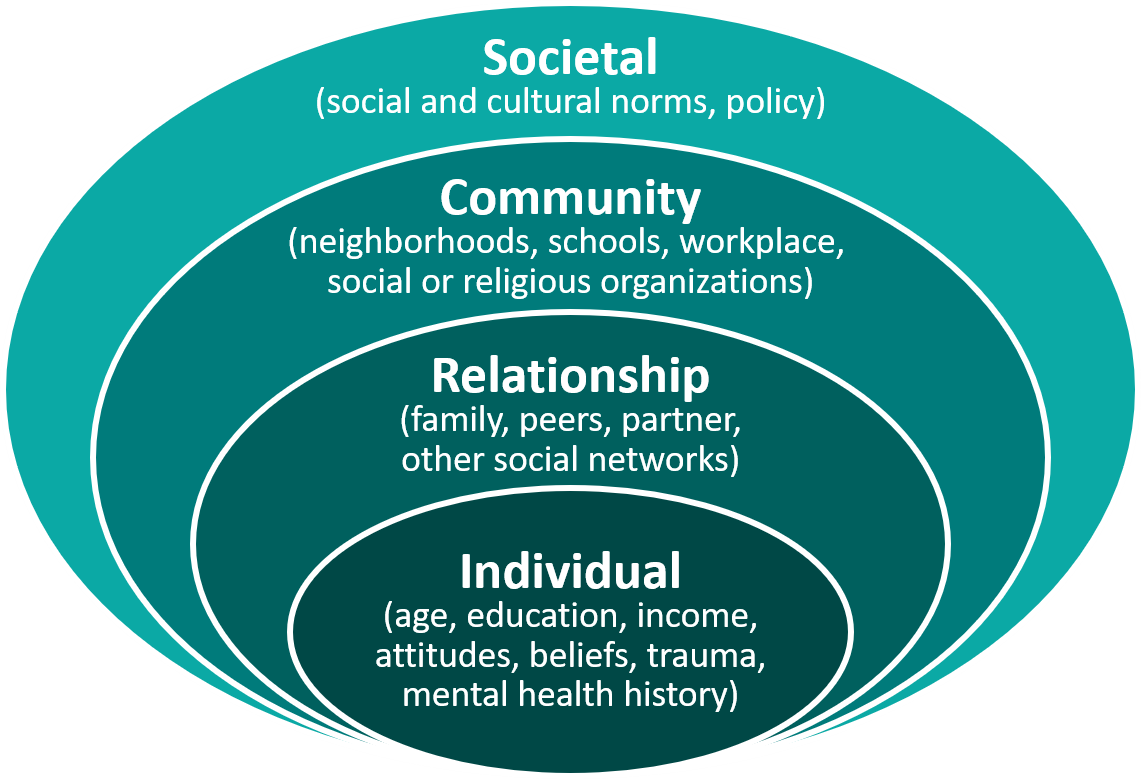
Figure 3. Social-Ecological Model
Determine at what level the campaign approach will be most effective in accomplishing the mission.
The scope can address the following questions:
- Based on available resources and the public health need, where are the anticipated targeting efforts needed
- What is feasible given the time and resources at hand?
Inventory existing and potential stakeholder relationships and map engagement levels.
- Identify existing advisory groups, education and outreach channels, and partner outreach programs across federal agencies or in the private sector (especially within the science and clinical communities) and determine the level of engagement required for each. See the tool Stakeholder Inventory Tools for sample tools for analyzing stakeholder engagement.
- As part of the overall PHE response, consider whether there are any requirements for the campaign to include any groups or program representatives as part of its oversight team or as advisors.
- Depending on the nature of the emergency, and the scope of the response, a coalition of external partners who contribute expertise and resources toward a common goal may be necessary.
- It may be the case that the partner organization has existing relationships to leverage for this effort; in other cases, the oversight team will need to pursue new strategic advisory relationships as well as more localized engagements.
Determine and plan to obtain the best available data.
- Identify the types of data most helpful to determining (or altering) the scope of the campaign and how outcomes are measured.
- Consider how scientific discovery (clinical and research-based) regarding the PHE will affect the overall campaign’s goals, tactics, and resources. See Appendix F for a reference sheet on understanding science during a PHE. Especially during time-sensitive responses to PHEs, emerging scientific real-world data presents both challenges and opportunities for action as it is discovered.
- What processes can be integrated into the campaign to embrace available data while pursuing more evidence through research studies and randomized control trial results as they become available?
- Identify the required processes for handling proprietary data sets to avoid missteps or overpromises.
|
Clarify the response approach.
- Consider how the effort will be administered. Is a singular national voice and effort anticipated? Or should the effort be coordinated nationally, but implemented at the state or local level?
- Should campaign materials or spokespeople communicate in languages other than English? Are there linguistic nuances to consider within communities affected by the PHE (e.g., regional terminology or dialects) that could impact oral or written comprehension?
- Should the response be led by a “.gov” or a “.org” voice?
- Should community partners be funded or otherwise financially supported?
Assess the risk appetite for public-private partnerships.
- Many benefits can be gained through partnerships with private sector (non-profit and commercial) entities, including expertise, resources, and existing partner relationships.
- Consider sensitivities in how the public may interpret partnerships as selective endorsement of a corporation or other entity, or public expectations that the campaign will achieve an unspoken goal because of a partner’s involvement.
- Consider methods to be as transparent as possible regarding the nature of public-private partnership roles and contributions, and how the team may prepare for unforeseen events that affect partner contributions to the campaign.
Establish an Oversight Team
Additional information about the oversight team
A high-functioning oversight team relies on each member’s contributions. As leaders and team members are selected, the oversight team should establish clearly defined roles and responsibilities. See the resource Example Oversight Team and CMT Solutions with Roles and Responsibilities for example oversight team roles, responsibilities and attributes of leaders suited to each role.
In conjunction with selecting team members, establishing a governance system sets the tenets for effective and efficient public services and defines expectations during the campaign. The governance system provides the processes to guide the “oversight function that is aligned with the organization’s governance model and encompasses the [campaign] lifecycle” (Project Management Institute, 2013)
The oversight team establishes the campaign development lifecycle (see Figure 1). as their approach for campaign operations and assigns to the team various functional responsibilities for each phase. Specific oversight team responsibilities for each phase are described below.
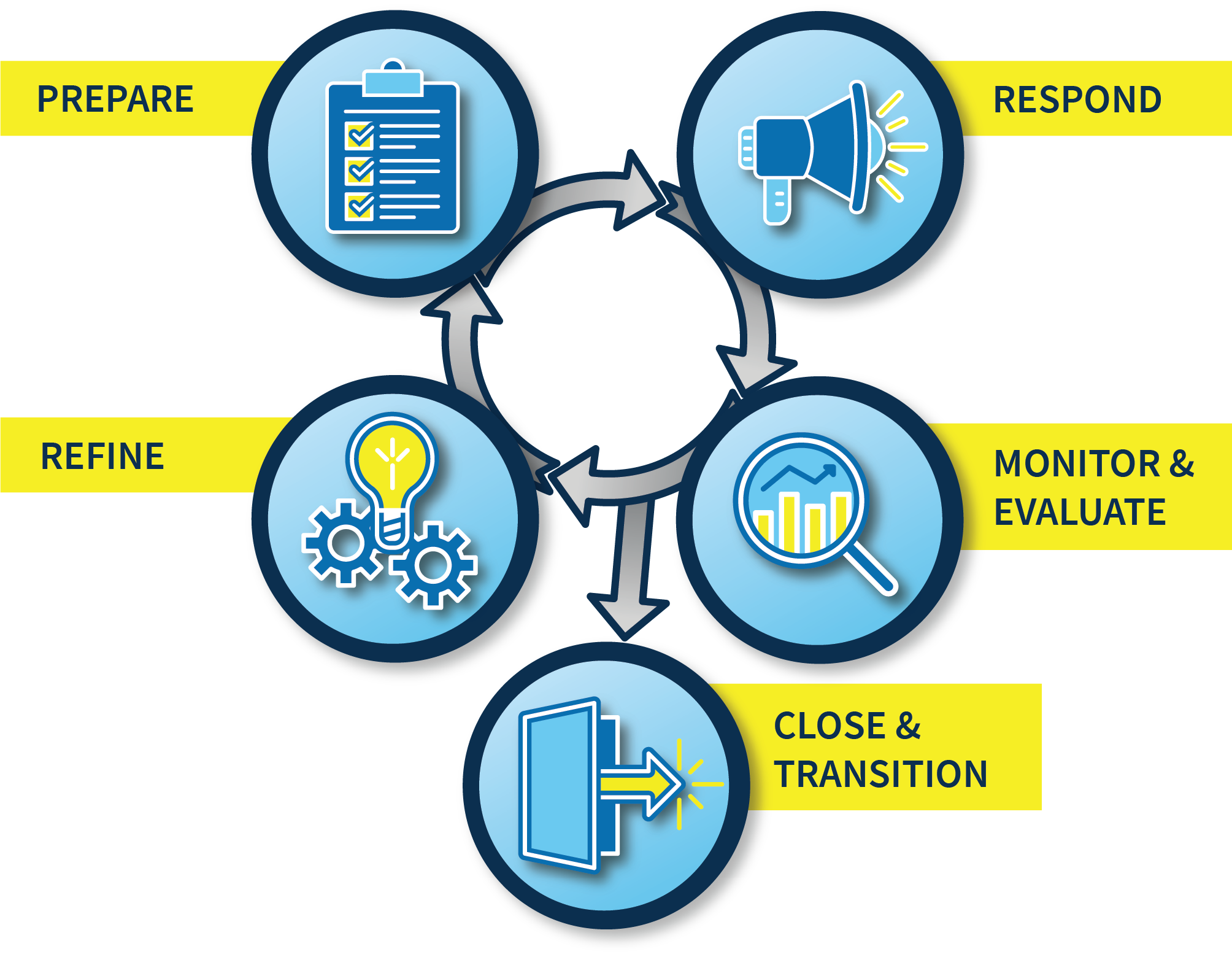
Figure 1. Campaign Development Lifecycle
Prepare
During this phase, the oversight team typically has limited information and is focused on quickly learning about the PHE and its effect on populations. Its central purpose initially is to equip the campaign for success. When indicated, the oversight team should:
- Rapidly stand up a campaign management team (CMT) with a clearly defined leader and distinct campaign responsibilities as soon feasible after mission assignment (Establish a Campaign Management Team).
- The decision to stand up a CMT is dependent upon the range, dynamics, as well as the expected duration of the PHE.
- Work with the CMT (if established) to determine the campaign’s desired outcomes (Define Desired Outcomes), potential impact factors (Identify Factors that May Impact Campaign Success), close-out strategy (Develop the Campaign Response and Close-Out Strategy), and monitoring and evaluation framework (Establish the Monitoring and Evaluation Framework).
Respond
During this phase, the oversight team focuses on the development of operational plans. The oversight team is accountable for formally launching the campaign and approving execution plans that conform to the campaign strategy and goals. If a CMT or management working group is not established, they are also responsible for the day-to-day campaign operations. During this phase, the oversight team should:
- Determine how the federal government will seek community support to meet the mission.
- Identify, track, and mitigate risks to ensure mission success.
- Make decisions to ensure that the overall strategy is followed.
Monitor & Evaluate
During this phase, the oversight team reviews insights obtained by monitoring the evolving PHE, how scientific discovery influences population health guidelines, and the effect of the campaign’s operational activities on the PHE. Using this information, the oversight team makes data-driven decisions on how to apply the campaign resources. During this phase, the oversight team should:
- Review insights and follow the decision-making framework to ensure all decisions are data-driven and tracked.
- Make decisions to adjust the strategy and operations to ensure campaign goals and desired outcomes are on track to be achieved.
- Report to executive-level senior officials.
Refine
During this phase, the oversight team and the CMT (if established) co-manage decision-making to adjust the campaign based on the evolving PHE and insights gleaned from monitoring and evaluating campaign operations. This includes the responsibility to:
- Record all changes and track progress. If large changes are sanctioned, action plans for specific campaign actions, such as communication or outreach, should be developed and approved for implementation by the CMT.
Close & Transition
During this phase, the oversight team determines when and how to close and transition the campaign. Transparent action plans and lines of responsibility can secure campaign materials and allow the campaign to reinforce objectives and facilitate a smooth adjustment to new leadership or oversight. During this phase, the oversight team should:
- Develop and execute the close-out and transition plan.
- Analyze and report on the campaign’s overall impact on the PHE.
With effective planning, preparation, and delineation of roles and responsibilities, the campaign PHE response helps leaders manage uncertainty and ensure the campaign remains an effective component of the overall PHE response.
Establish a Campaign Management Team
Additional information about the Campaign Management Team
Ideally, the CMT – with a designated leader – should be stood up within two weeks of mission assignment. See the tool Campaign Management Team Stand Up Worksheet for the campaign management team stand up worksheet.
The oversight team should identify a single individual to speak on behalf of the CMT who reports regularly on campaign progress. The oversight team should empower the CMT to make decisions on tactical and operational risks that affect campaign implementation objectives to ensure responsiveness to timely developments and opportunities. Decisions on matters that pose significant risk to the campaign’s strategic outcomes should be elevated to the oversight team.
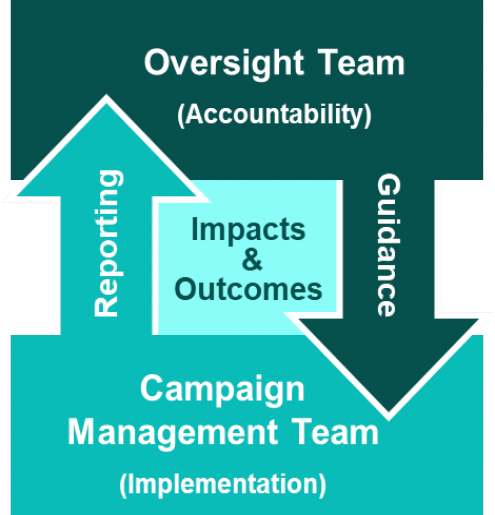
Figure 4. Oversight and CMT Relationship
Additional CMT responsibilities include:
- Coordination
- Communication
- Performance tracking and progress reporting to the oversight team
- Staffing and training
- Knowledge sharing and transfer
- Budget audits
- Risk management
Like a program management office model, the CMT model also establishes, improves, and communicates processes that support the mission and align the team governance structures. Often, many activities occur simultaneously, such as the development of the CMT structure and development of the campaign response and close-out strategy.
In preparing for the community activation campaign, the oversight team should assess how best to structure the CMT, and budget accordingly to support its work throughout the duration of the PHE.
The oversight team can evaluate several structural considerations when deciding the CMT’s scope of operations. These are listed below:
Key Activities and Considerations for establishing the Campaign Management Team
Identify which functions are required to execute the campaign response strategy
- This should include risk management, cost management, staffing models, communication models, and budget management.
- Staffing models could include experts in the medical field, health communication science, media, digital services, community engagement, project management, and risk management.
Rapidly assess external contracting or grant needs to enable CMT operations.
- Determine if internal federal staff (within or across agencies and departments) have sufficient expertise across multiple necessary disciplines (e.g., knowledge management, performance management, schedule management, quality management, and change management) to support the CMT’s work.
- Allocate budget, contracting, or staffing agreements for contract support or detail requisitions for the duration of the PHE.
Develop an organizational structure that aligns with the CMT functions.
Include CMT leadership and definition of roles, responsibilities, and key stakeholder groups. See the resource Example Oversight Team and CMT Solutions with Roles and Responsibilities for an example CMT Structure with Roles & Responsibilities.
- See Figure 5 for an example of organizational structure based on functions. Some of these functions could be managed together (e.g., media, communication), provided the team members’ expertise and time allocations are sufficient to effectively manage activities.

Figure 5. Example Campaign Management Team Organizational Structure
Identify the tools and systems needed to support CMT structure and functions.
- Confirm whether new software is required, or if existing resources can be reallocated. Determine if open source or proprietary services are appropriate, and whether the technology adequately protects privacy and security. Decide whether the oversight team also needs access to the CMT’s tools and systems for decision-making.
- Develop processes to manage all activities, communications, and outputs. Determine reporting, data, and information requirements, and ensure data use agreements are completed.
Determine budget requirements and constraints.
- Resources are finite, even during an emergency.
- How much funding is available to support the efforts? What are the budget allocation requirements, authorization requirements, timelines, and funding mechanisms?
- Determining this up front will impact decisions about how to allocate resources on priority actions to reach campaign goals.
- Budget limitations may also influence the extent to which partners and/or state and local staff may be asked to contribute in-kind support.
Define Desired Outcomes
Additional information about the outcomes and metrics
When defining outcomes for the campaign, be sure to identify incremental thresholds that can be observed and recorded at each of the four stages of community activation: social awareness; community education; community understanding; and community activation (see Figure 6 below).
|
This data should be shared with all members of the campaign team to support the multiple actions necessary to accomplish strategic goals and subsequent action plans. Transparency and inclusion will allow the entire campaign team to adjust and appropriately adapt their work.

Figure 6. Stages of Community Activation
|
Identify Factors that May Impact Campaign Success
Additional information about the identifying factors that may impact campaign success
While other steps in the preparatory stage should be completed as quickly as possible, performing foundational scans and resilience plans can be initiated concurrently as the oversight team addresses other priority items. These initial scans are necessarily incomplete and require additional research and analyses for deeper insights to design, launch, and execute the campaign (RESPOND: Develop and Execute the Community Activation Campaign).
Several techniques, strategies, and frameworks may be helpful to inform strategic plan development and implementation of action plans:
Environmental scan
An environmental scan allows for evaluation of existing resources, relationships, and capacity within and across federal agencies to develop and manage the campaign.
- The environmental scan may also identify areas where external support would augment federal engagement to expedite or enhance campaign activities and achieve specific goals or milestones, such as when working with federally recognized Tribes or in communities that emphasize guidance from religious leaders.
Strengths, Weaknesses, Opportunities, and Threats (SWOT) analysis
Conducting a SWOT analysis helps the campaign anticipate how it may be received by stakeholders and prepare for potential criticism. It also identifies the campaign federal sponsors’ strengths and opportunities that can be leveraged as part of the strategy.
Strengths, Opportunities, Aspirations, and Results (SOAR) analysis
An alternative to SWOT, the SOAR is more future-oriented than SWOT and addresses accountability through outlining results.
Road Testing
A road test is an iterative, rapid prototyping approach used to refine the design and implementation of a program strategy or intervention (U.S. Department of Health and Human Services, 2018).
|
Develop the Campaign Response and Close-Out Strategy
Additional information about the campaign response and close out strategy
This planning effort requires a significant amount of oversight team collaboration to align the strategy with concurrent public health emergency (PHE) response efforts.
Consider a strategic planning tool, such as a logic model (Centers for Disease Control and Prevention, 2018) to help illustrate the shared relationships among inputs from resources, activities, activity outputs, outcomes, and impact for the campaign. This will provide transparency to the thinking behind campaign design and show how specific campaign activities will lead to the desired results. See the tool Example Logic Model and Templates for an example logic model and a template.
Key Elements of the Response and Close-Out Strategic Plan
- Campaign Desired Outcomes (Define Desired Outcomes)
- Determine what the campaign aims to achieve.
- Campaign Priorities and Timeline
- Identify campaign priorities.
- Create a timeline for how and when the campaign will initiate activities.
- Assess how campaign priorities will be met in the near and longer term.
- Establish criteria for campaign launch.
- Develop milestones the campaign will meet as it progresses toward the desired outcomes.
- Campaign Audience
- Declare who the message recipients will be and if these may change overtime.
- Campaign Message(s)
- Identify what the audience will be asked to do, how they can do it, and whether that request will change over time.
- Campaign Messengers
- Provide guidance and conditions for the types of groups the campaign will recruit to deliver and amplify the messages.
- Message Delivery: Strategy and Tactics
- Specify how the campaign will maximize message impact with the audience.
- Campaign Resources and Strengths
- Document the consequential factors the campaign can leverage now and over time. Use the campaign management team budget and relevant analyses (Identify Factors that May Impact Campaign Success).
- Campaign Risks, Challenges and Gaps
- Plan for how the campaign will mitigate and reduce barriers caused by internal and external factors.
- Campaign Road Testing (Identify Factors that May Impact Campaign Success)
- Create methods so the campaign can know if its approach and actions are working as intended. Consider what plans need to be in place to test, adjust, and redeliver messages or methodologies.
- Campaign Transition and Close-Out Strategy
- Identify triggers or signals that will indicate the campaign can end or transition. Assign team members to prepare plans to transition or close the campaign.
Establish the Monitoring and Evaluation Framework
Additional information about the monitoring and evaluation framework
The framework provides information so the campaign team can focus efforts on activities that successfully achieve the mission.
- Regular monitoring and evaluation as a campaign process norm supports the teams’ ability to act decisively on changing data and scientific discovery.
- Monitoring and evaluation are continual processes that allow the oversight team and campaign management team (CMT) to track decisions’ effects on campaign results.
|
Campaign execution requires iterative adjustments, collaboration, and communication with other team members. The framework provides guidelines for transparent decision-making and methods to for implementing and communicating changes required to the strategic, tactical, or operational plans. See the tool Monitoring and Evaluation Framework Template for an example monitoring and evaluation framework template.
Key Decisions and Activities to Establish the Monitoring and Evaluation Framework
Key Decisions and Activities to Establish the Monitoring and Evaluation Framework
- Define the performance indicators and metrics and align data to campaign decision points.
- The framework must be structured to correlate data and metrics to the desired outcomes, which are tracked at the strategic and operational levels.
- The framework should also include explicit requirements for review. See the tool Example Outcomes Metrics for example outcomes and metrics.
- Determine if existing data is sufficient or if influential data gaps should be addressed.
- Identify required data sources (current and yet-to-bemeasured).
- Create proxy measures if they are not available or do not yet exist.
- Determine whether data use agreements and/or data disclosures are required. The Department of Health and Human Services (HHS) and several divisions have developed guidance for data access and use (HHS, 2017; Centers for Medicare & Medicaid Services, 2021).
- Create a streamlined data collection and coordination plan that focuses on essential information.
- Develop and standardize methods for data analytics and visualization to streamline decision-making.
- Monitoring progress on strategic, tactical, or operational goals likely requires designing separate but integrated visualization tools, such as dashboards or other resources.
- Each team member may rely on different data sources to track fluctuations in campaign effectiveness and appropriate data communication to support consensus understanding for decision makers.
- Develop reporting structures and cadence.
- Clarity between the oversight team and the CMT regarding what will be reported, its frequency, and methods is critical. Decisions also should address how more detailed reporting to other entities, including the overall public health emergency response leadership, will be managed if it becomes warranted later.
- Draft a stakeholder reporting plan.
- In addition to internal reporting, determine whether, when, and how progress and outcomes will be reported to the public and other stakeholders.
- Develop a decision framework that will formulate campaign response options and track decisions.
- A decision framework for response options can assist implementers to identify options and potential differences in outcomes depending on the chosen option.
- Include a decision tracker that records data availability and under what conditions decisions were made. The tracker should follow governance principles established earlier between the oversight team and CMT.
- Begin planning for overall campaign outcome and impact evaluation efforts (CLOSE and TRANSITION the Campaign).
- Determine if pre-test measures are needed for campaign impact evaluation.
Tools and Resources
Tool(s)
Logic model development guidance with a template and a completed example provided to illuminate the response strategy for the FCR campaign.


